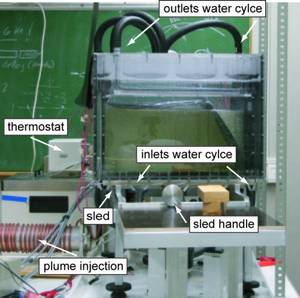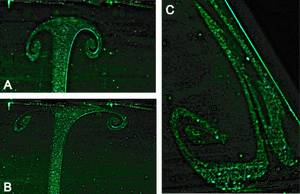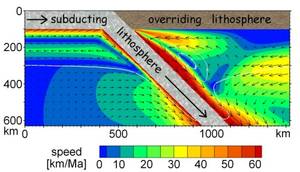Generation of melts under mid ocean ridges
Numerical modeling of plume-ridge interaction and mantle heterogeneities
The Earth mantle is generally divided into two main parts the upper and the lower mantle. The upper mantle extends from the Earth surface down to 670km. The mantle between 670 km down to the core mantle boundary at 2900 km is called the lower mantle. The upper mantle is further divided into different compartments, with the so called crust forming the outer thin shell, about 6 km thick under the oceans and 30 to 80 km thick in continents. The crust and the rigid (stiff) part of the upper mantle form the lithosphere, which can be up to to 200 km thick. It is broken into the lithospheric plates moving on top of the ductile (weak) part of the upper mantle also called the asthenosphere.
Although entirely composed of solid rocks (apart from melts filling into pores of the rock in the very upper mantle), the mantle is in a permanent slow motion of few to tens of cm per year. This motion can be physically described as highly viscous fluid flow and, thus, can be modeled in laboratory experiments and numerically explored using computational simulations.
Within this project, both numerical models of mantle flow and laboratory experiments are used to explore the direction and magnitude of mantle flow. We focus on mid-ocean ridges and deep-seated hot upwellings in the mantle, so-called mantle plumes, interacting with the lithosphere. If a mantle plume rises close to a mid-ocean ridge, as for example at Iceland, plume-ridge interaction causes extensive volcanism. Our goals are exploring the heterogeneity of the mantle rock composition and identifying geodynamical connections between ocean island volcanism and processes within the mantle.
Currently we develop a new numerical code, a computer program to perform high-resolution simulations of flow, temperatures and melting processes in the mantle. We also conduct laboratory experiments in a Perspex reservoir filled with corn syrup. Here we investigate the rising of hot diapirs in a given flow field that behave similar to mantle plumes rising within the Earth.
Our project is part of a larger priority program (SPP 1144), bringing together groups of different scientific fields as biology, geology, geochemistry and geophysics. Visit the SPP 1144 webpage for detailed summaries of all projects, including this project: http://www.ifm-geomar.de/index.php?id=spp1144&L=1)
Funding: DFG 2006-2010
Contact: Jörg Hasenclever, Matthias Hort, Jason Phipps Morgan (Cornell University, Ithaca, USA)

- Top: Laboratory setup of the analogue experiments

- Center: Rising 'mantle plumes' which are deflected by the general mantle convection

- Bottom: Numerical simulation of the flow associated with subduction processes.
